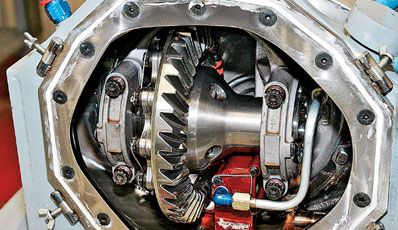
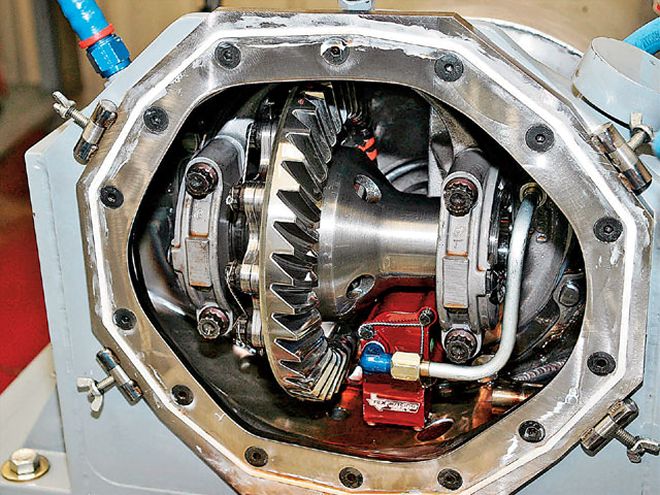
As racers and engine builders are pushing rpm limits that are higher than ever before, more and more race teams are finding the need to run rearend coolers. If you regularly run extra-distance races of 100 laps or more, you may fall into this category. Don't make the mistake of thinking that you're fine if you aren't burning up your gears or breaking locker springs. Although you may not be tearing up equipment, high heat levels in your rearend may be costing you horsepower.
Whether you run a 9-inch Ford-style rearend or a quick-change, officials at gear specialist Tex Racing say tests have revealed that overheated gear oil in a rearend can cost as much as 10 hp at the rear wheels. This can be a problem because of localized heating. As the ring-and-pinion gears mesh, intense heat is generated at the point of contact. Simply pointing an infrared temp gun at the rearend cover will tell you the temperature of the cover, but not the real temperatures being reached between the pinion and ring gear teeth. On a quick-change rear, the quick-change gears are also a source of localized heating.
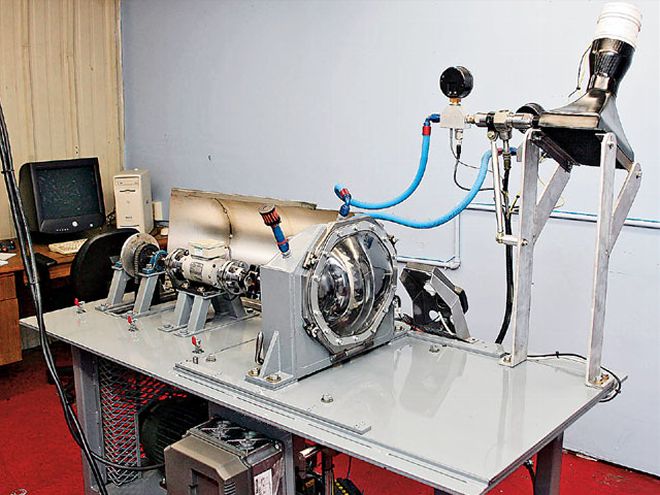 The parasitic dyno uses a large electric motor (below the table) to spin a rear gear setup on the test bench where temperature, pressure, and volume of lubricant flow can be measured in real time.
The parasitic dyno uses a large electric motor (below the table) to spin a rear gear setup on the test bench where temperature, pressure, and volume of lubricant flow can be measured in real time.
Generally, synthetic rearend lubricant should not be allowed to exceed 250 degrees F. Factors that can play a role in heating up the rearend lubricant include engine power, rpm range, traction in the rear tires, gear ratio (the higher the ratio, the more heat it produces), the length of the race, and even the efficiency of the cooling system if one is installed.
Oil Coolers Don't make the mistake of thinking an oil cooler for the rearend is the same as a radiator for your engine. Because rearend lube is so much more viscous than water, an oil cooler must be designed differently. First, they are much smaller because the overall cooling needs of a rearend or transmission is much less then an internal combustion engine. The cooler, however, must still receive a steady flow of cool air to work. Mounting an oil cooler flat against some sheetmetal, such as the rear firewall, will severely reduce its efficiency. If you cannot find an area with good airflow, try attaching an electric blower to move a steady supply of air through the cooler.
Because of the lubricant's greater viscosity, a single-pass cooler is almost always your best choice. The key is to maximize flow through the cooler while minimizing pressure. Oil pressure is your enemy here because horsepower is required to produce it. So the more pressure you are generating inside your oil cooler, the more power you are robbing from your rear wheels. In addition to a single-pass cooler, you should also run coolant lines that have an AN sizing of at least -8, with a minimum of 90-degree fittings. Finally, always try to mount your cooler as close to the oil pump as possible. The farther the pump has to move the lubricant, the more power the oil pump requires.
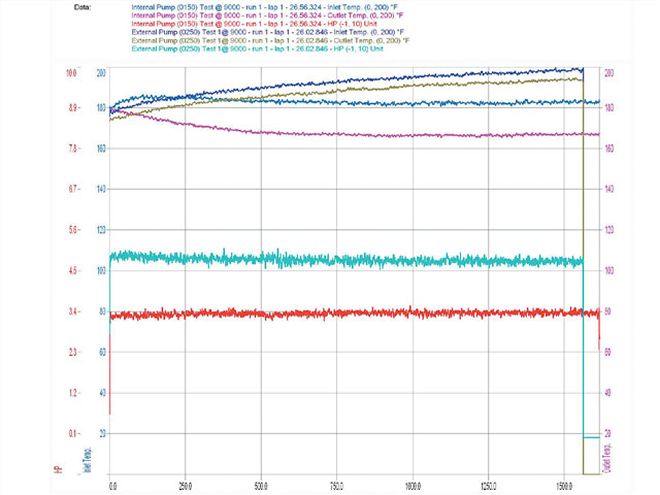 The parasitic dyno uses a large electric motor (below the table) to spin a rear gear setup on the test bench where temperature, pressure, and volume of lubricant flow can be measured in real time.
The parasitic dyno uses a large electric motor (below the table) to spin a rear gear setup on the test bench where temperature, pressure, and volume of lubricant flow can be measured in real time.
Oil Pump Efficiency Within the last year, Tex Racing has undertaken a comprehensive research program to determine exactly how to produce the most efficient rearend cooling system possible. But before they could do that, Tex Racing's R&D department had to invent its own "parasitic drag dyno" so it could measure exactly what was going on in the rearend.
The parasitic dyno is actually quite a marvel. It uses a large electric motor to spin a driveshaft to which a Ford 9-inch rearend is connected. The electric motor is precise enough that it can hold its speed within 1 rpm at 9,000 rpm. Instrumentation has also been installed that can tell how much horsepower is required to turn the driveshaft at any given rpm.
The test rearend unit is set up with an oil pump, a rearend cooler, a ducted fan to blow a steady stream of air through the cooler, and all the necessary hoses to plumb everything. On one side of the apparatus, instrumentation feeds back information concerning lubricant temperature and pressure in the front of the oil cooler as well as temperature, pressure, and flow at the oil-cooler outlet.
Parasitic Dyno <strong>Parasitic Dyno</strong><br />This graph is straight off Tex Racing's new parasitic dyno. It is from a test comparing Tex Racing's new internal pump with a beltdriven external pump. Horsepower (the red and blue lines at the bottom) is measured in terms of the amount the pump requires, or drag, and uses the numbers on the far left. As you can see, to reduce heat at the cooler outlet by approximately 20 degrees (using the same oil cooler), the internal pump needed almost two fewer horsepower.
<strong>Parasitic Dyno</strong><br />This graph is straight off Tex Racing's new parasitic dyno. It is from a test comparing Tex Racing's new internal pump with a beltdriven external pump. Horsepower (the red and blue lines at the bottom) is measured in terms of the amount the pump requires, or drag, and uses the numbers on the far left. As you can see, to reduce heat at the cooler outlet by approximately 20 degrees (using the same oil cooler), the internal pump needed almost two fewer horsepower.
"The parasitic dyno gives us a scientific testbed that we can use to test one variable at a time," explains Tex Racing's General Manager, Jesse Havens. "The goal is to pull as much heat out of the gear oil as possible while requiring a minimum amount of energy for the pump. In other words, we are trying to find the pump that provides the greatest efficiency with the least parasitic drag."
The test methodology for this system, according to Havens, is to cover the oil cooler and spin the rearend until the oil temperature reaches 180 degrees at a specific rpm. Once that temperature is achieved, the electric fan is turned on to provide air to the oil cooler, and then the team sits back to see how long and at what temperature the oil will stabilize. A more efficient system will cool the oil more quickly and achieve a lower constant temperature at just about any rpm level.
The most interesting finding here is that, according to Havens, the most efficient pump system achieves both maximum lubricant cooling and minimum parasitic drag. In other words, you can have your cake and eat it, too. The key is to provide adequate flow levels through the cooler with minimal pressure. Pressure is the enemy here, because it serves to heat the oil and increase parasitic drag in the pump. If the cooler and lines are constant, you can reduce your flow until the oil temp begins to rise. The lowest flow that still achieves proper cooling will produce the least pressure and require the least horsepower to spin the pump.
When testing different oil pumps, Havens said that Tex Racing found almost every pump on the market moves way too much volume, which increases pressure. At racing rpm levels, between 6,000 and 8,000 rpm, many rearend oil pumps are capable of over 50 psi through a standard oil cooler. Havens says a well-designed system can get by with as little as 5 psi, which translates to a reduction of 2-3 hp in drag. Interestingly, at racing rpm, an oil pump operating at 5 psi is generally pumping approximately 20 gallons per minute, which is ideal flow.
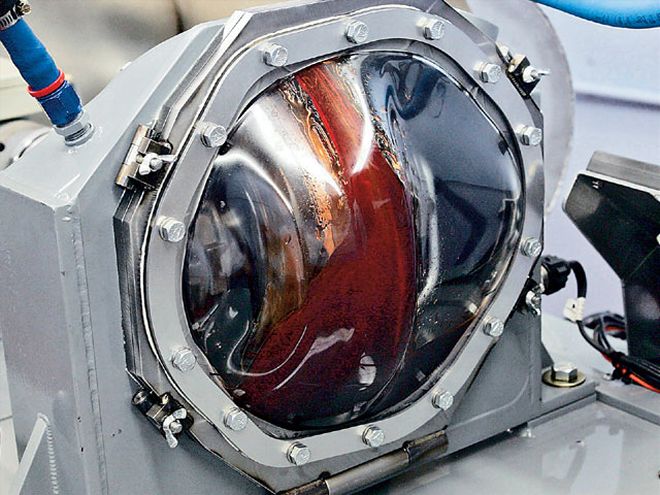 The clear rear cover actually serves a real purpose. Being able to observe how the oil moves inside the centersection allows Tex's R&D team to determine numerous things-one of which is the best location for the oil pump pickup so that it will not be located inside a pocket of aerated oil. This photo is of cold oil, with the rearend spinning at 1,000 rpm. As you can see, it barely makes it up the back of the cover.
The clear rear cover actually serves a real purpose. Being able to observe how the oil moves inside the centersection allows Tex's R&D team to determine numerous things-one of which is the best location for the oil pump pickup so that it will not be located inside a pocket of aerated oil. This photo is of cold oil, with the rearend spinning at 1,000 rpm. As you can see, it barely makes it up the back of the cover.
In the course of its studies, Tex Racing determined the need to produce an oil pump with a new style to take advantage of the findings. The result is an internal oil pump that drives off the back of the pinion gear. This direct-drive style of pump, versus a beltdriven pump, has not yet been widely accepted in Saturday night racing classes because a different pump must be installed in each rearend assembly you carry to the track. This can cost a little extra money up front, but Havens says the difference in drag between a direct drive and belt system can easily be 1 hp or more, depending on the type of belt and amount of wear. The Tex Racing pump also uses rotors that are just 0.200 inch thick to bring pumping pressure within spec. A relief valve also vents extra pressure if necessary. The pump is lubricated by the oil in the rearend housing and only needs to be rebuilt whenever you pull your center chunk down for a gear rebuild. Havens says the new pump, while available for any Ford 9-inch rearend, has been particularly well received in the Nextel Cup ranks and has been in winning race cars-including restrictor-plate cars, where minimizing drag is so critical.
Another interesting finding that most Saturday night racers can use is that rearend oil pressure can spike as high as 150 psi if the driveline is brought to racing rpm while the oil is still cold. This often happens in racing if you don't have a chance to properly warm up the car before taking your qualifying lap. Pushing cold gear oil at 150 psi will cost you at least 5 hp, and you can't afford any drag on your driveline during qualifying. Also, Havens says most coolers are only designed to reliably handle 100 psi, and if you are suffering from oil cooler leaks, they quite likely came from cold-oil pressure spikes and not just vibrations from racing.
Havens also stresses that you don't have to take his word for it. If you own an onboard diagnostics system, you can easily configure it to test your oil inlet and outlet temperatures at the oil cooler as well as pressure during a test day at the racetrack. It may not be as precise as Tex Racing's parasitic dyno, but it will give you an idea of exactly what is going on inside your race car.
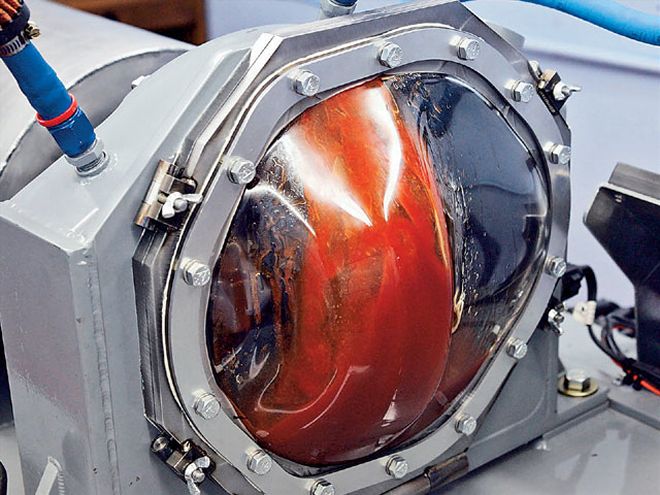
Here, the rearend is spinning at 2,400 rpm. The oil temperature is rising slowly, and the lighter color indicates aeration.
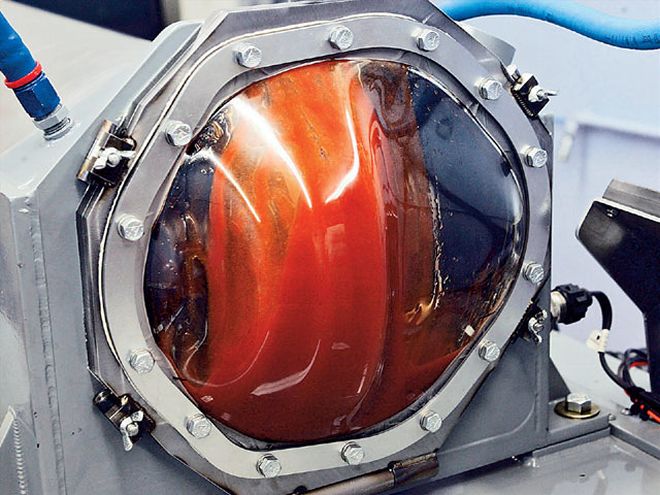
This shot was taken with the rear gears spinning at 3,700 rpm. The oil being directed over the top of the inside of the housing is dripping onto the carrier bearings as well as the pinion bearing, ensuring that they are properly lubricated.
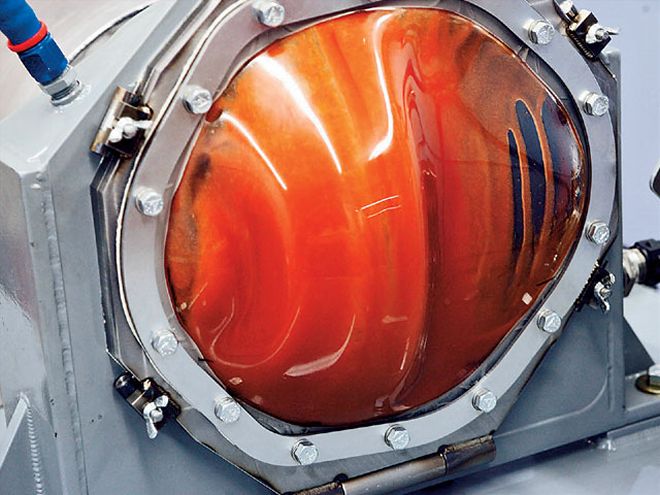
Finally, we are at racing speed: 7,100 rpm. As you can see, there is lubricant everywhere. This is why it is dangerous to try to lower your lubricant level too much, unless you have an oil pump dropping oil straight onto the ring gear.
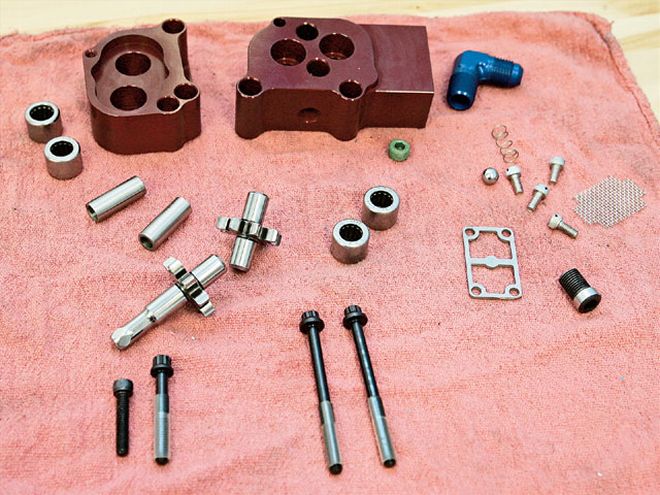
Here's the extent of Tex Racing's new oil pump. To keep oil pressure low enough, the pump gears are only 0.200 inch thick.
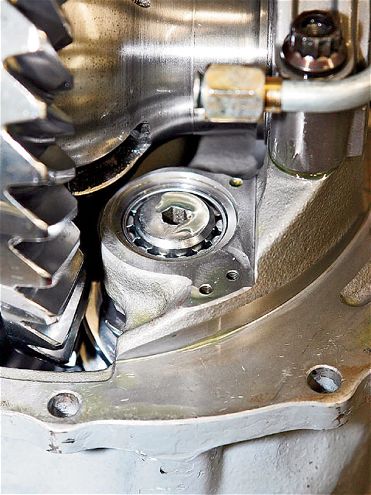
The pump is driven off of a driveshaft that keys into this hex cut and into the back of the pinion gear. Havens says this is the most efficient system Tex Racing has found so far.
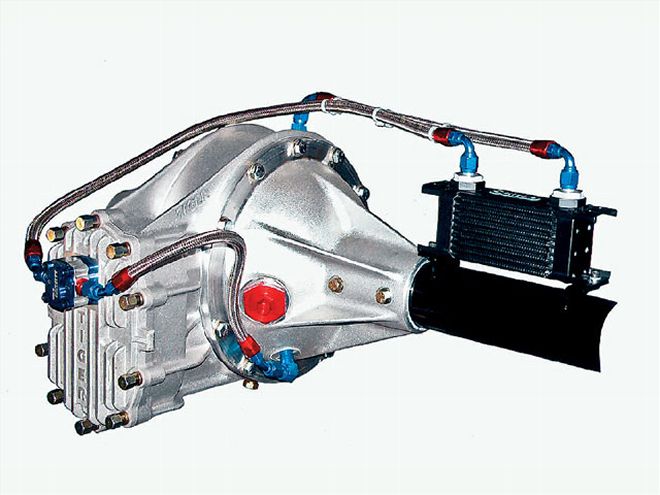
If you race a quick-change rear, Tiger Rear Ends produces a similar oil pump that spins off the back of the jack shaft. Tiger also sells a kit that allows you to mount your oil cooler directly to the axle tube, which is a great way to minimize the complexity of the plumbing.